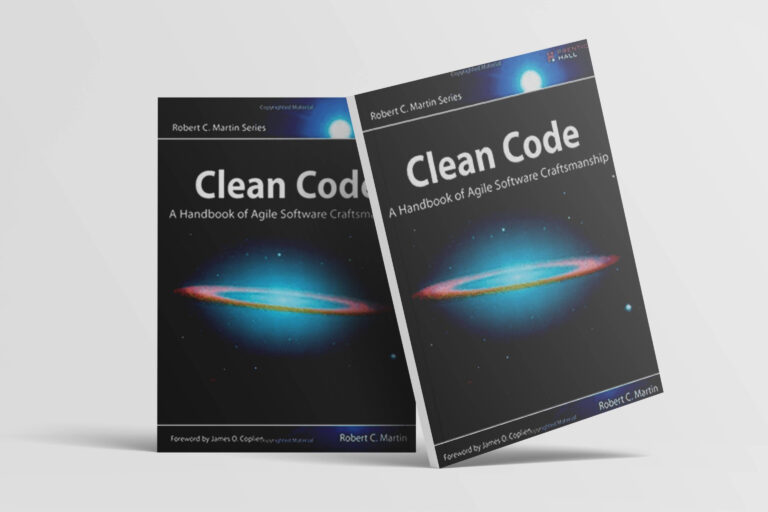دانلود کتاب Clean Code: A Handbook of Agile Software Craftsmanship

- حتی کد بد هم میتواند کاربرد داشته باشد. اما اگر کد تمیز نیست، میتواند سازمانِ توسعهدهنده را به زانو درآورد. هر سال، ساعت بیشمار و منابع قابل توجهی به دلیل نوشتن کد بد از دست میرود. اما لازم نیست این اتفاق رخ دهد.
- متخصص نرم افزار سرشناس، رابرت سی مارتین، یک پارادایم انقلابی را با کدنویسی تمیز ارائه میدهد: کتاب راهنمای توسعه نرمافزار به روش چابک. مارتین همراه با همکارانش از شرکت Object Mentor، بدون مقدمه چینی روشهای ایده آلی را در توسعه نرم افزارها به روش چابک برای تمیز کردن کد، در این کتاب خلاصه کردهاند که در وجود شما درجاتی از استادی نرم افزار را به وجود میآورد و شما را به یک برنامهنویس بهتر تبدیل میکند، اما اگر فقط شما بر روی دستور العملهای این کتاب کار کنید.
- کاری که شما انجام خواهید داد، چیست؟ شما در حال خواندن کد -در حقیقت مقدار زیادی کد- خواهید بود. چالش شما این موضوع خواهد بود که فکر کنید چه چیزی در کد درست است و چه چیزی در کد درست نیست. مهمتر از همه، چالش شما این موضوع خواهد بود که ارزشهای حرفهای خودتان را دوباره شناسایی کنید و تعهد دادن را به مهارت خودتان اضافه کنید.
کتاب Clean Code به 3 بخش تقسیم میشود:
- بخش اول به توصیف اصول، الگوها و شیوه های نوشتن کد تمیز میپردازد.
- بخش دوم شامل مطالعات موردی در مورد افزایش پیچیدگی است. هر بررسی این وضعیتها، یک تمرین برای تمیز کردن برخی از کدها میباشد، تبدیل کردن کدی که دارای مشکلاتی است به کدی که درست و موثر است.
- سومین قسمت این کتاب، نتیجه نهایی کار ما میباشد. این قسمت، یک فصل است که شامل یک لیست از اکتشافات و نشانهها در زمان تولید کد و بررسی مطالعههای موردی میباشد. نتیجه این روش دانش پایه ما را زمانی که کد را مینویسیم و میخوانیم و تمیز میکنیم، نشان
Even bad code can function. But if code isn’t clean, it can bring a development organization to its knees. Every year, countless hours and significant resources are lost because of poorly written code. But it doesn’t have to be that way. Noted software expert Robert C. Martin presents a revolutionary paradigm with Clean Code: A Handbook of Agile Software Craftsmanship . Martin has teamed up with his colleagues from Object Mentor to distill their best agile practice of cleaning code “on the fly” into a book that will instill within you the values of a software craftsman and make you a better programmer—but only if you work at it. What kind of work will you be doing? You’ll be reading code—lots of code. And you will be challenged to think about what’s right about that code, and what’s wrong with it. More importantly, you will be challenged to reassess your professional values and your commitment to your craft. Clean Code is divided into three parts. The first describes the principles, patterns, and practices of writing clean code. The second part consists of several case studies of increasing complexity. Each case study is an exercise in cleaning up code—of transforming a code base that has some problems into one that is sound and efficient. The third part is the payoff: a single chapter containing a list of heuristics and “smells” gathered while creating the case studies. The result is a knowledge base that describes the way we think when we write, read, and clean code. Readers will come away from this book understanding How to tell the difference between good and bad code How to write good code and how to transform bad code into good code How to create good names, good functions, good objects, and good classes How to format code for maximum readability How to implement complete error handling without obscuring code logic How to unit test and practice test-driven development This book is a must for any developer, software engineer, project manager, team lead, or systems analyst with an interest in producing better code.
